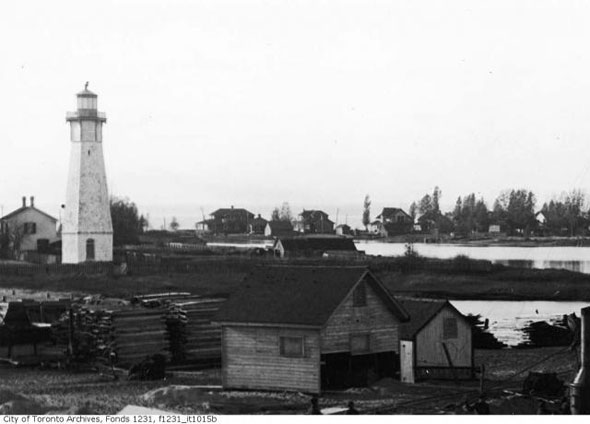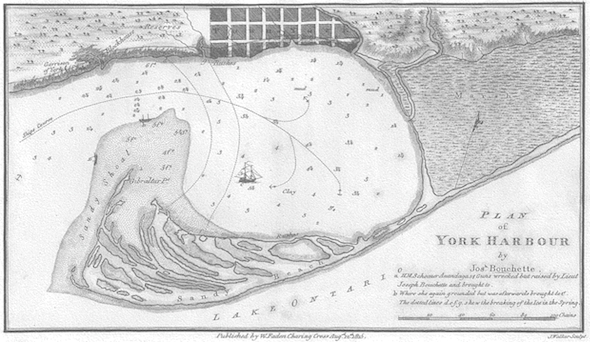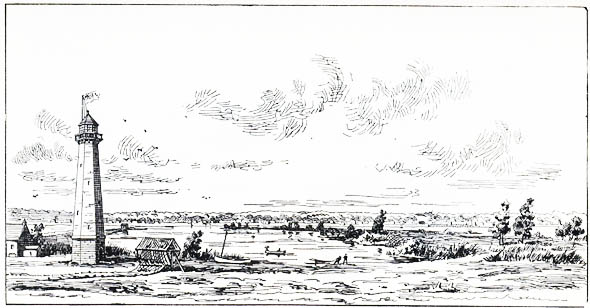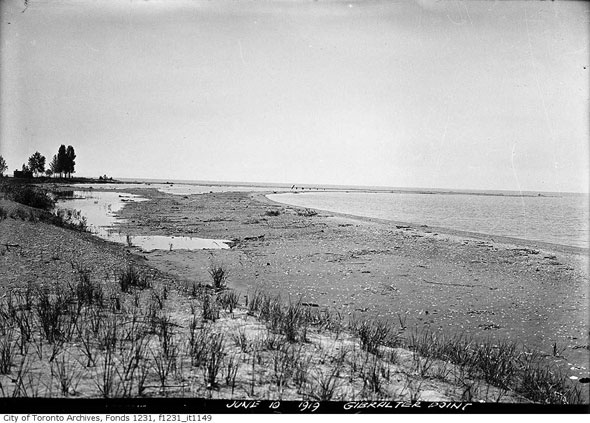 The
Gibraltar Point Lighthouse on the western tip of the Toronto Islands is
Toronto's oldest remaining structure. Built from a mix of Queenston and
Kingston stone, its guiding light helped ships navigate the city's
harbour and lake shoreline for more than 150 years.
The
Gibraltar Point Lighthouse on the western tip of the Toronto Islands is
Toronto's oldest remaining structure. Built from a mix of Queenston and
Kingston stone, its guiding light helped ships navigate the city's
harbour and lake shoreline for more than 150 years. Despite ushering countless ships away from ruin, the lighthouse is perhaps best known for the mysterious disappearance of its first keeper, J. P. Rademuller (sometimes spelled Raden Muller.) Leaving behind only bloodstains and speculation, the accepted story of grisly murder leaves more questions than answers.
 Started
in the early part of the 19th century, the Gibraltar Point Lighthouse
once stood on the western shore of Centre Island, then part of a sandbar
attached to the mainland. Upon its completion in 1808, the stone
structure was built to 52 metres - 25 metres lower than its present
height - and was powered by sperm oil, a flammable substance refined
from a liquid in the head of sperm whales.
Started
in the early part of the 19th century, the Gibraltar Point Lighthouse
once stood on the western shore of Centre Island, then part of a sandbar
attached to the mainland. Upon its completion in 1808, the stone
structure was built to 52 metres - 25 metres lower than its present
height - and was powered by sperm oil, a flammable substance refined
from a liquid in the head of sperm whales. The lighthouse's secluded location and glowing beacon was, by design, easy to spot. It was perhaps its status as a local landmark that gave rise to its use as a waypoint for smugglers hoping to dodge taxes on imported alcohol. If stories are to be believed, it was common knowledge that Rademuller kept a stock of something potent on the property.
On the night of 2nd January, 1815, Rademuller was at his post in the lighthouse when, according to reports written after the event, a group of soldiers arrived from Fort York with an eye for a sip from the lighthouse keeper's illicit brew. What happened next is a little hazy.
 Either
Rademuller welcomed the hooch hunters and they began to drink or the
lighthouse keeper decided it he didn't want to liquor up the soldiers
and tried to turn them away. Either way - it was curtains for
Rademuller. The next day, a bloodstain on one of the wooden steps
leading up to the oil lamp was the only evidence of his untimely
departure.
Either
Rademuller welcomed the hooch hunters and they began to drink or the
lighthouse keeper decided it he didn't want to liquor up the soldiers
and tried to turn them away. Either way - it was curtains for
Rademuller. The next day, a bloodstain on one of the wooden steps
leading up to the oil lamp was the only evidence of his untimely
departure.With no body and no suspects, authorities had a hard time pinning down exactly what had transpired. Someone must have had some clue, though. An informed search of the area west of the lighthouse turned up part of a coffin and a jawbone. Whether it actually belonged to Rademuller is up for debate - contemporaneous investigative methods were unable to tell for certain. What is known is that the tragic lighthouse keeper was never seen again.
 According
to newspaper reports published after the discovery of human remains, a
group of soldiers did stand trial for Rademuller's murder but none were
ever convicted. With that, the case went cold. Almost 200 years later
no-one is any the wiser about exactly what happened on that chilly
night. With all evidence lost to time, it's unlikely any answers will be
forthcoming.
According
to newspaper reports published after the discovery of human remains, a
group of soldiers did stand trial for Rademuller's murder but none were
ever convicted. With that, the case went cold. Almost 200 years later
no-one is any the wiser about exactly what happened on that chilly
night. With all evidence lost to time, it's unlikely any answers will be
forthcoming.Naturally, the bloody story lends itself perfectly to paranormal and there are countless tales of ghost sightings, mysterious sounds, and other creepy happenings in and around the lighthouse. Keep an eye out for ghouls next time you ride by after dark.
Photos: City of Toronto Archives and Wikimedia Commons.
No comments:
Post a Comment